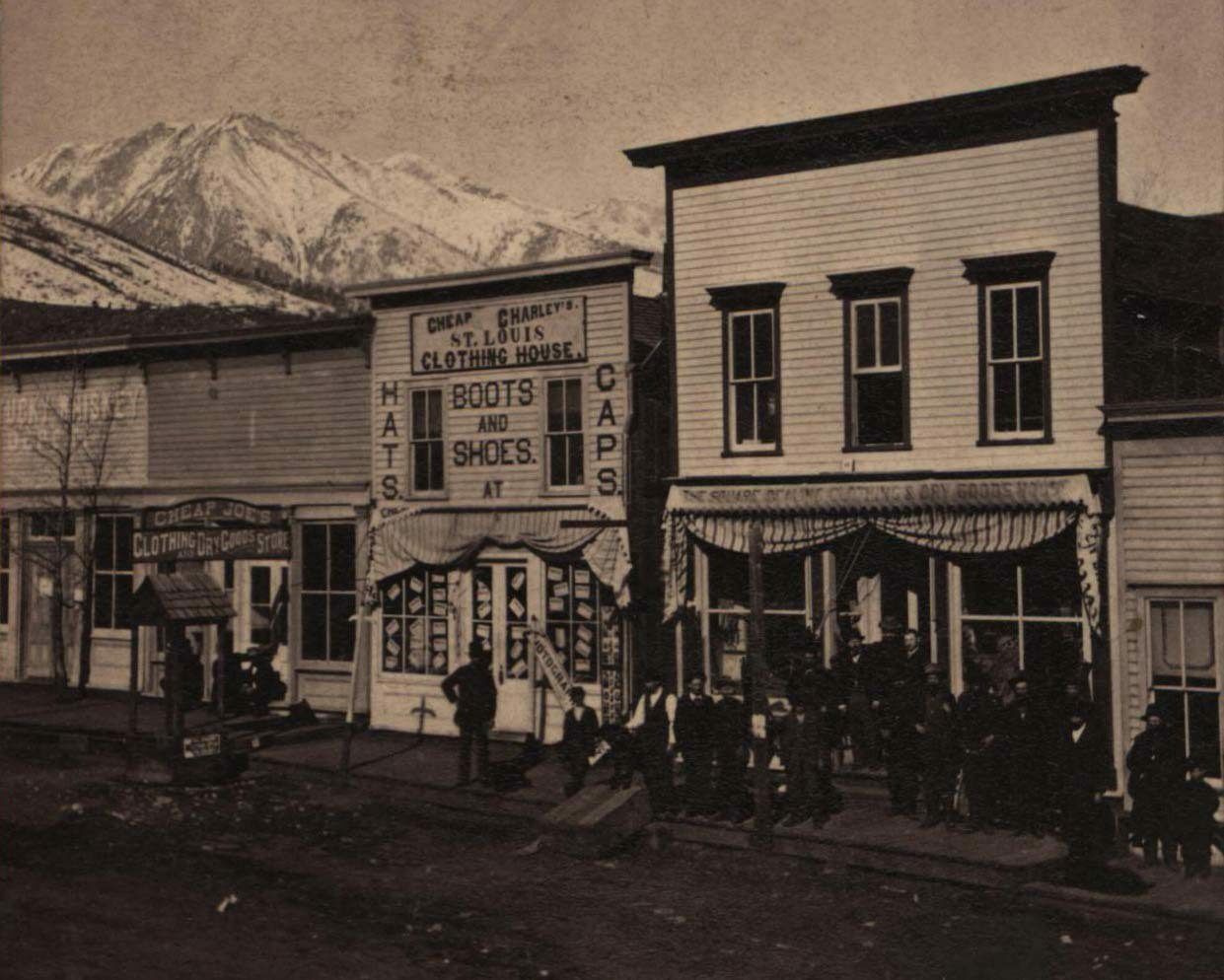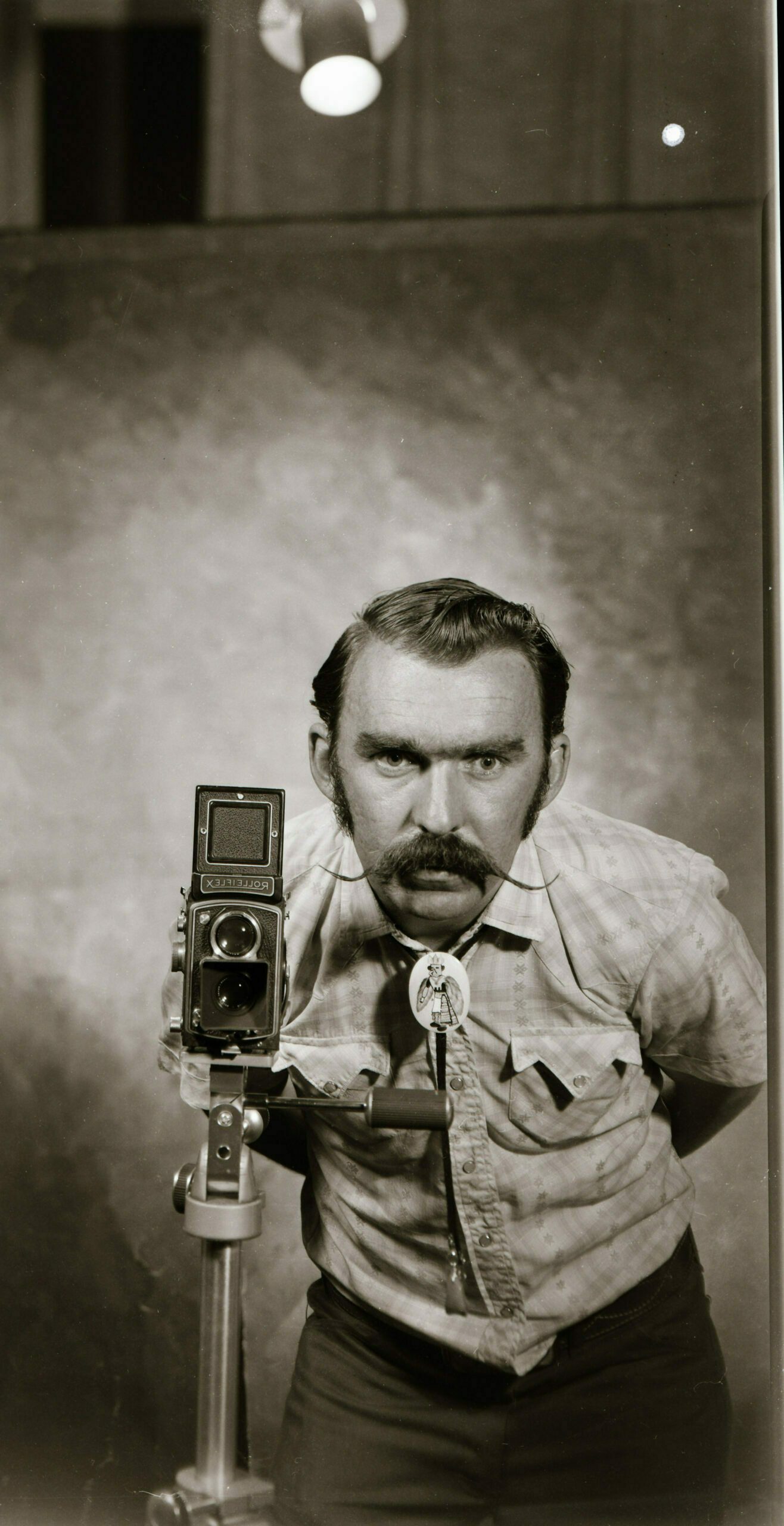
Maysville photographed by Frank Kuykendall
At the same time William Henry Jackson was photographing scenery in Colorado, Frank Kuykendall was recording images of the Monarch Mining District. The above image is from the Donna Nevens Collection and depicts Cheap Charley’s clothing store in Maysville, Colorado. It’s one of the first images taken in the Arkansas Valley.

Unknown gentleman as photographed by C.H. Clark
Once Salida was established in 1880, the Messrs. Mellen & Brumfield opened a tent gallery on F Street, selling their photographs. Later, Brumfield would team up with a Mr. Byers and together they opened the first permanent gallery in Salida on First Street in 1883. They stayed about a year.
In 1884, C. Henry Clark opened a gallery in Salida. He kept busy taking images of the Denver & Rio Grande railroad and buildings around town.
A threefold tragedy struck Clark during the 1880s, the first being when his son died. Then, in January 1888, Peter Mulvany’s new hotel caught fire, which spread and burned out about sixty businesses in town, including Clark’s. He was in the process of moving (to 229 F Street) so most of his equipment was saved but all of his early day images of Salida were lost in the fire. About a year later, his daughter died of typhoid fever. Clark was a Christian Scientist and decided against calling a doctor to help her. Townsfolk found out and the rebuke was swift. After Ada’s death, Clark and his wife left town.

Charles and May Hanks as photographed by Charles Erdlen
Charles Erdlen, who had been a partner of Clark’s, took over their gallery on the second floor of Hall & Howard’s grocery store at 229 F (today 227) and sold landscape photography and took portraits of townsfolk. Charles also had photo galleries in Saguache and Buena Vista.

W.C. Alexander as photographed by Frank Ray
The 1890s saw a boom in the photo business in Salida. In 1894, Charles Erdlen was voted in as Chaffee County treasurer and sold his business to Frank Ray in 1898 who stayed in business for about a decade. Pictured here is William C. Alexander, popular optician and jeweler in town. He was married to Salida’s first female councilwoman, Harriet Alexander, for whom the Salida Airport is named.

Denver & Rio Grande Roundhouse ca. 1900 photographed by Newell Meigs
Newell Meigs moved to Salida in 1896 and opened the Corner Lunch Room at the F Street Bridge. In 1898, he bought the Smith Bros. book and stationery store; he dabbled in photography as a hobby but some of his images are the clearest ever recorded of Salida. The image above of the Denver & Rio Grande Roundhouse and Shops was taken by Meigs about 1900. The roundhouse had suffered a devastating fire in 1892 and the doors at that time were straight rectangles. After reconstruction, the engine doors were built with arches, as shown above. Newell would have set up a portable darkroom in order to fix the image to a glass negative.

Frank & Gertrude Gimlett’s 1897 wedding photo as taken by Charles Skinner. Frank is more commonly known as the Hermit of Arbor Villa.
Charles Skinner traveled to Salida in 1892, setting up a temporary gallery in an iron-clad building on the corner of 2nd and E Streets. He didn’t stay long, hopping a train west to San Francisco. But Salida beckoned him back and he bought the property next to Ray’s two-story gallery in 1900. Charles built a studio specifically for photography which included a skylight and housed with wide angle lenses and an electric flashlight machine. Charles was a popular photographer; he advertised ‘Baby Days’ at the gallery at Christmastime, taking free portraits of kids two and younger:
“Last Monday was ‘baby day’ at the photograph gallery of C.E. Skinner on upper F street, and it was a big day, too. There were some ninety-two mothers there, each with a bright little tot to be entertained from a distance as it sat alone, long enough to get an acceptable negative made. At the close of this baby day inaugurated by the enterprising artist, one hundred excellent negatives had been taken, and all pronounced it a most successful event. It is no small matter to entertain the infant and keep it in the proper mood and position for a good photo, but Mr. Skinner is equal to the emergency, and concluded his hundred sitting in good order.” –Salida Mail, Nov. 21, 1902
Charles used a popular technique of the era by enhancing his black and white negatives with India ink, watercolors, and crayons, giving them a touch of life.

Helen Hanks as taken by Henry Hay
Charles Skinner left town in 1903 and after Newell Meigs partnered with Joseph Barber in 1904, they moved into Skinner’s gallery. Then Joe left town in 1906 after getting a job as a traveling salesman for the Denver Photo Supply Company. Newell soon left the business as well and became bookkeeper at First National Bank. For a time, he was Salida’s city clerk.
Frank Ray was the last photographer left standing until he quit the business in 1908. He sold the gallery to newcomer Henry R. Hay. Henry bought the entire building in 1923 and with that, became Salida’s leading photographer specializing in general photography, portraits, Kodak finishing, and picture framing.
Helen Hanks worked for Henry after her graduation from Salida High School. When Henry died in 1937, Helen took over the business.

Two-year-old Jim Roll as photographed by Helen Hanks.
Helen sold The Hay Studio at 227 F to Roy Morris in 1954 who subsequently renamed it the Morris Photo Shop. In 1971, it was sold again and renamed the Photo Image Studio.

Roy Morris


